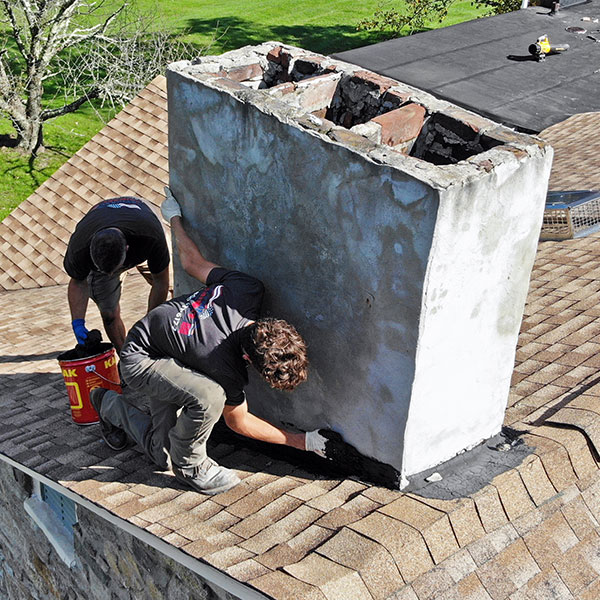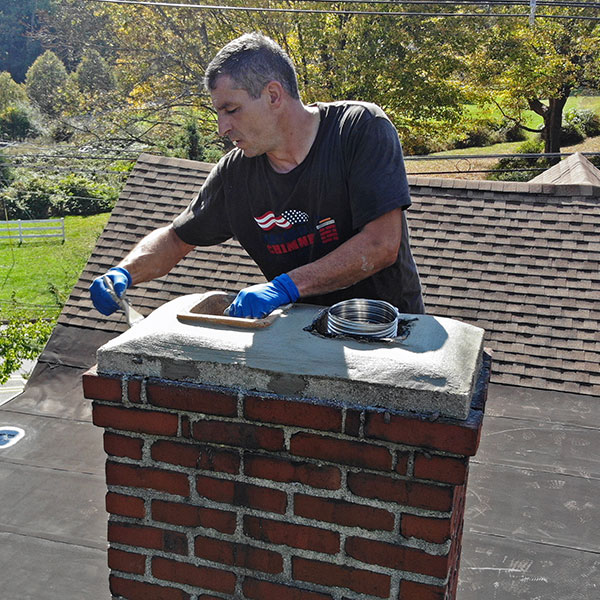Why Is My Chimney Leaking?
If you have a leak in your chimney, you need help fast. National Chimney Cleaners of Fairfield County, CT, and Morris County, NJ, performs a lot of chimney repair work to address leaky chimneys and the damage they cause. We’ve seen it all, and we’d like to share with you the most common causes of chimney leaks and how to resolve them.
 Problems with chimney flashing
Problems with chimney flashing
Flashing is the material that skirts the base of the exterior chimney, sealing the space between it and the roof. When flashing is warped, rusted, unseated or missing, water can move down into “invisible” areas of your home and cause severe damage.
Water falling directly into the chimney
If you operate your chimney with no chimney cap or other protective component on top, rain and snow have a free path into the chimney. Once inside, an ongoing cycle of water damage is sure to begin.
Damaged chimney cap, flue cover or chase top
You may have a protective component that has been eaten away by rust or damaged by a severe weather event. It doesn’t take much of a gap to let water in.
Deteriorated chimney crown
A chimney crown is a slab at the top of the chimney designed to keep water and debris out of interior parts of the structure. Usually made of concrete, chimney crowns can crack and deteriorate over time.
Brick and Mortar Damage
Chimney bricks can be cracked by lightning strikes, pounding hail, chimney fires and old age. The mortar between the bricks is prone to crumbling. These two problems will allow water to move into the masonry and lead to a destructive chimney leak.
What chimney water damage means
Water can harm the chimney structure, chimney components and areas of the home in several ways:
• Structural instability that results in a leaning chimney or a chimney collapse
• Interior brick decay that isn’t seen in its early stages
• Roof damage around the chimney
• Damage to walls, ceilings and flooring
• Mold growth in the interior chimney, attics, behind walls and anywhere water collects and mold spores can spread
• Rusted fireplace damper
• Firebox damage
Inspecting a leaky chimney
The first step in addressing a leaky chimney is a licensed chimney inspection. Your inspector will listen to your description of the problem and then take a close look at your chimney. A qualified chimney inspector will want to know:
• Where water is getting in
• Why it’s getting in
• The level of damage present at the entry point
• Related damage in other areas
Repairing a leaky chimney
Qualified chimney crews know how to stop a chimney leak and repair the damage caused by it. Some of the most common strategies include:
• Installation of a new, secure chimney cap or chase top
• Replacement of damaged chimney flashing
• Sealing cracks in a chimney crown or rebuilding it
• Brick replacement
• Tuckpointing to replace crumbling mortar
• Rebuilding sections of the chimney or the entire chimney
 When repairs are complete, your chimney technician can apply a water sealant to the exterior masonry.
When repairs are complete, your chimney technician can apply a water sealant to the exterior masonry.
The help your leaky chimney needs
National Chimney Cleaners specializes in the repair of leaky chimneys and the damage they cause.
If your chimney is leaking, you are missing a chimney cap, have a rusty chase cover, a cracked chimney crown, or damaged flashing speak with a chimney leak expert today at (800) 631-6177. You can also get in touch with our handy contact form.

 Problems with chimney flashing
Problems with chimney flashing When repairs are complete, your chimney technician can apply a water sealant to the exterior masonry.
When repairs are complete, your chimney technician can apply a water sealant to the exterior masonry.